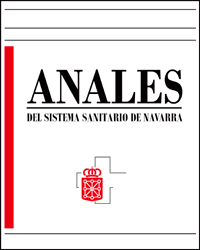Proteína C reactiva y lactato deshidrogenasa en el diagnóstico de la obstrucción intestinal en un servicio de urgencias
DOI:
https://doi.org/10.23938/S1137-6627/2016000100013Palabras clave:
Obstrucción intestinal, Proteína C Reactiva (PCR), Lactatodeshidrogenasa (LDH), cáncer colorrectal, urgenciasResumen
Fundamento. La obstrucción intestinal es una de las urgencias quirúrgicas más frecuentes. Su diagnóstico se basa esencialmente en la historia clínica, la exploración física y las pruebas de imagen. El objetivo de este estudio fue analizar el valor diagnóstico de reactantes de fase aguda en pacientes con obstrucción intestinal benigna versus maligna.
Método. Se ha realizado un estudio de cohortes histórico sobre 53 pacientes sometidos a cirugía por obstrucción intestinal y/o cáncer colorrectal no obstructivo. Los pacientes se encuadraron en 3 grupos: grupo 1 (cáncer colorrectal con obstrucción intestinal) (n=23), grupo 2 (obstrucción intestinal benigna) (n=10) y grupo 3 (con cáncer de colon no obstructivo) (n= 20). Se determinan los valores plasmáticos iniciales de la proteína C reactiva (PCR) y el enzima lactato deshidrogenasa (LDH).
Resultados.La PCR se elevó cuantitativamente más en pacientes con obstrucción intestinal benigna (grupo 2) (p=0,001), mientras quela LDH en el grupo 1 (pacientes con cáncer obstructivo). Los niveles plasmáticos de LDH fueron significativamente mayores en los grupos con obstrucción intestinal (Grupos 1 y 2) que en pacientes sin obstrucción (p<0,001). Niveles plasmáticos de PCR mayores de 11 mg/l y de LDH mayores de 317 U/L mostraron una validez diagnóstica aceptable para diferenciar los pacientes con obstrucción intestinal, con áreas bajo la curva ROC de 80% (IC 95% = 68-92%) y de 86% (IC 95%= 75-96%) respectivamente. Su validez diagnóstica para diferenciar el origen benigno o maligno es menor, con áreas bajo la curva ROC de 56% para niveles de PCR > 24 ng/l (IC 95 % = 30-82%) y de 52% (IC 95% = 29-74%) para niveles de LDH > 359 U/L.
Conclusión. La determinación de las concentraciones plasmáticas dela PCR puede ayudar al diagnóstico de la obstrucción intestinal y orientar hacia su origen benigno o maligno en los servicios de urgencias.
Palabras clave. Obstrucción intestinal. Proteína C reactiva (PCR). Lactato deshidrogenasa (LDH). Cáncer colorrectal. Urgencias.
Descargas
Citas
1. HUSTEY FM, MELDON SW, BANET GA, GERSON LW, BLANDA M, LEWIS LM et al. The use of abdominal computed tomography in older ED patients with acute abdominal pain. Am J Emerg Med 2005; 23: 259-265.
https://doi.org/10.1016/j.ajem.2005.02.021
2. MACKENZIE S, THOMSON SR, BAKER LW. Management options in malignant obstruction of the left colon. Surg Gynecol Obstet 1992; 174: 337-345.
3. CARRARO PG, SEGALA M, CESANA BM, TIBERIO G. Obstructing colonic cancer:
failure and survival patterns over a ten-year follow-up after one-stage curative
surgery. Dis Colon Rectum 2001; 44: 243-250.
https://doi.org/10.1007/BF02234300
4. DEANS GT, KRUKOWSKI ZH, IRWIN ST. Malignant obstruction of the left colon. Br J Surg 1994; 81: 1270-1276.
https://doi.org/10.1002/bjs.1800810905
5. RUNKEL NS, HINZ U, LEHNERT T, BUHR HJ, HERFARTH CH. Improved outcome after emergency surgery for cancer of the large intestine. Br J Surg 1998; 85: 1260-1265.
https://doi.org/10.1046/j.1365-2168.1998.00855.x
6. IRVIN TT, GREANEY MG. The treatment of colonic cancer presenting with intestinal obstruction. Br J Surg 1977; 64: 741-744.
https://doi.org/10.1002/bjs.1800641015
7. PHILLIPS RK, HITTINGER R, FRY JS, FIELDING LP. Malignant large bowel obstruction. Br J Surg 1985; 72: 296-302.
https://doi.org/10.1002/bjs.1800720417
8. SERPELL JW, MCDERMOTT FT, KATRIVESSIS H, HUGHES ES. Obstructing carcinomas of the colon. Br J Surg 1989; 76: 965-969.
https://doi.org/10.1002/bjs.1800760932
9. TSILIDIS KK, BRANCHINI C, GUALLAR E, HELZLSOUER KJ, ERLINGER TP, PLATZ EA et al. C-reactive protein and colorectal cancer risk: a systematic review of prospective studies. Int J Cancer 2008; 123: 1133-1140.
https://doi.org/10.1002/ijc.23606
10. HEIKKILA K, EBRAHIM S, LAWLOR DA. A systematic review of the association between circulating concentrations of C reactive protein and cancer. J Epidemiol Community Health 2007; 61: 824-833.
https://doi.org/10.1136/jech.2006.051292
11. CEVIKEL MH, OZGÜN H, BOYLU S, DEMIRKIRAN AE, AYDIN N, SARI C et al. C-reactive protein may be a marker of bacterial Translocation in experimental intestinal obstruction. ANZ J Surg 2004; 74: 900-904.
https://doi.org/10.1111/j.1445-1433.2003.02681.x
12. BOERMEESTER MA, STOKER J. Accurate predictors for acute diverticulitis. Biomark Med 2013; 7: 131-137. doi: 10.2217/bmm.12.86.
https://doi.org/10.2217/bmm.12.86
13. XHARRA S, GASHI-LUCI L, XHARRA K, VESELAJ F, BICAJ B, SADA F et al. Correlation of serum C-reactive protein, white blood count and neutrophil percentage with histopathology findings in acute appendicitis. World J Emerg Surg 2012; 7: 27. doi: 10.1186/1749-7922-7-27.
https://doi.org/10.1186/1749-7922-7-27
14. YU CW, JUAN LI, WU MH, SHEN CJ, WU JY, LEE CC et al. Systematic review and meta-analysis of the diagnostic accuracy of procalcitonin, C-reactive protein and white blood cell count for suspected acute appendicitis. Br J Surg 2013; 100: 322-329.
https://doi.org/10.1002/bjs.9008
15. MEYER ZC, SCHREINEMAKERS JM, VAN DER LAAN L. The value of C-reactive protein and lactate in the acute abdomen in the emergency department. World J Emerg Surg 2012; 7: 22.
https://doi.org/10.1186/1749-7922-7-22
16. COYLE JP, BRENNAN CR, PARFREY SF, O'CONNOR OJ, MC LAUGHLIN PD, MC WILLIAMS SR et al. Is serum C-reactive protein a reliable predictor of abdomino-pelvic CT findings in the clinical setting of the non-traumatic acute abdomen?. Emerg Radiol 2012; 19: 455-462.
https://doi.org/10.1007/s10140-012-1041-4
17. MIKI C, KONISHI N, OJIMA E, HATADA T, INOUE Y, KUSUNOKI M et al. C-reactive protein as a prognostic variable that reflects uncontrolled up-regulation of the IL-1-IL-6 network system in colorectal carcinoma. Dig Dis Sci 2004; 49: 970-976.
https://doi.org/10.1023/B:DDAS.0000034556.48527.6e
18. MCMILLAN DC, WOTHERSPOON HA, FEARON KC, STURGEON C, COOKE TG, MCARDLE CS et al. A prospective study of tumor recurrence and the acute-phase response after apparently curative colorectal cancer surgery. Am J Surg 1995; 170: 319-322.
https://doi.org/10.1016/S0002-9610(99)80296-7
19. NOZOE T, MATSUMATA T, KITAMURA M, SUGIMACHI K. Significance of preoperative elevation of serum C-reactive protein as an indicator for prognosis in colorectal cancer. Am J Surg 1998; 178: 335-338.
https://doi.org/10.1016/S0002-9610(98)00204-9
20. LEE JS, KWON OY, CHOI HS, HONG HP, KO YG. Serum C-reactive protein level is a predictive factor for 14-day mortality of patients with advanced cancer who present to the emergency department with acute symptoms. Acad Emerg Med 2011; 18: 440-442.
https://doi.org/10.1111/j.1553-2712.2011.01034.x
21. MCMILLAN DC, CANNA K, MCARDLE CS. Systemic inflammatory response predicts survival following curative resection for colorectal cancer. Br J Surg 2003; 90: 215-219.
https://doi.org/10.1002/bjs.4038
22. OKUGAWA Y, YOKOE T, TOIYAMA Y, TANAKA K, INOUE Y, KUSUNOKI M et al. Preoperative C-reactive protein as a prognostic and therapeutic marker for colorectal cancer. J Surg Oncol 2008; 98: 540-544.
https://doi.org/10.1002/jso.21154
23. CANNA K, MCMILLAN DC, MCKEE RF. Evaluation of a cumulative prognostic score based on the systemic inflammatory response in patients undergoing potentially curative surgery for colorectal cancer. Br J Cancer 2004; 90: 1707-1709.
https://doi.org/10.1038/sj.bjc.6601757
24. NOZOE T, MATSUMATA T, KITAMURA M, SUGIMACHI K. Significance of preoperative elevation in serum C-reactive protein as an indicator for prognosis in colorectal cancer. Am J Surg 1998; 176: 335-338.
https://doi.org/10.1016/S0002-9610(98)00204-9
25. CROZIER JE, MCKEE RF, MCARDLE CS, ANGERSON WJ, ANDERSON JH, HORGAN PG et al. The presence of a systemic inflammatory response predicts poorer survival in patients receiving adjuvant 5-FU chemotherapy following potentially curative resection for colorectal cancer. Br J Cancer 2006; 94: 1833-1836.
https://doi.org/10.1038/sj.bjc.6603185
26. NOZOE T, MATSUMATA T, SUGIMACHI K. Preoperative elevation of serum C-reactive protein is related to impaired immunity in patients with colorectal cancer. Am J Clin Oncol 2000; 23: 263-266.
https://doi.org/10.1097/00000421-200006000-00011
27. GUNTER MJ, STOLZENBERG-SOLOMON R, CROSS AJ, LEITZMANN MF, WEINSTEIN S, WOOD RJ et al. A prospective study of serum C-reactive protein and colorectal cancer risk in men. Cancer Res 2006; 66: 2483-2487.
https://doi.org/10.1158/0008-5472.CAN-05-3631
28. SHIU YC, LIN JK, HUANG CJ, JIANG JK, WANG LW, HUANG HC et al. Is C-reactive protein a prognostic factor of colorectal cancer? Dis Colon Rectum 2008; 51: 443-449.
https://doi.org/10.1007/s10350-007-9133-z
29. CHIU HM, LIN JT, CHEN TH, LEE YC, CHIU YH, LIANG JT et al. Elevation of C-reactive protein level is associated with synchronous and advanced colorectal neoplasm in men.Am J Gastroenterol 2008; 103: 2317-2325.
https://doi.org/10.1111/j.1572-0241.2008.01952.x
30. ALLIN KH, NORDESTGAARD BG. Elevated C-reactive protein in the diagnosis, prognosis, and cause of cancer. Crit Rev Clin Lab Sci 2011; 48: 155-170.
https://doi.org/10.3109/10408363.2011.599831
31. GRAEBER GM, WUKICH DK, CAFFERTY PJ, O'NEILL JF, WOLF RE, ACKERMAN NB et al. Changes in peripheral serum creatine phosphokinase (CPK) and lactic dehydrogenase (LDH) in acute experimental colonic infarction. Ann Surg 1981; 194: 708-715
https://doi.org/10.1097/00000658-198112000-00009
32. EIGENTLER TK, FIGL A, KREX D, MOHR P, MAUCH C, RASS K et al. Dermatologic cooperative oncology group and the national interdisciplinary working group on melanoma. Number of metastases, serum lactate dehydrogenase level, and type of treatment are prognostic factors in patients with brain metastases of malignant melanoma. Cancer 2011; 117: 1697-1703.
https://doi.org/10.1002/cncr.25631
33. KOSTAKIS ID, VAIOPOULOS AG, PHILIPPOU A, PAPAVASSILIOU AG, KOUTSILIERIS M, KOURAKLIS G et al. Preoperative serum lactate dehydrogenase levels in colorectal and gastric cancer: a hospital-based case-control study. Tunis Med 2010; 88: 409-413.
34. ABAZA H, GHANEM A, JMAL A, BOUSSEN H, HARZALLAH L, RAHAL K et al. Importance of determination of C reactive protein (CRP), carcinoembryonic antigen (CEA) and lactic dehydrogenase (LDH) in colorectal cancer. Ned Tijdschr Geneeskd 2011; 155: A2848.
35. PIHL E, HUGHES ES, NIND AP, NAIRN RC. Colonic carcinoma: clinicopathological correlation with immunoreactivity. Br Med J 1975; 3: 742-743.
https://doi.org/10.1136/bmj.3.5986.742
36. FRAGER D, BAER JW, MEDWID SW, ROTHPEARL A, BOSSART P. Detection of intestinal ischemia in patients with acute small-bowel obstruction due to adhesions or hernia: efficacy of CT. AJR Am J Roentgenol 1996; 166: 67-71.
https://doi.org/10.2214/ajr.166.1.8571907
37. FERNÁNDEZ C, FUENTES M, DEL PRADO N. Análisis e interpretación de un estudio en investigación clínica. En: Miró O (ed.). Manual básico para el urgenciólogo investigador. De la idea original a la publicación final. Madrid: Ergon, 2013. pp: 79-102.
38. RODRÍGUEZ CERRILLO M, JIMÉNEZ DE DIEGO L. Manejo del paciente con obstrucción intestinal en un Servicio de Urgencias. Emergencias 1999; 11: 361-364.
39. KOUKOURAKIS MI, GIATROMANOLAKI A, SIVRIDIS E, GATTER KC, HARRIS AL. Tumour angiogenesis research group. Lactate dehydrogenase 5 expression in operable colorectal cancer: strong association with survival and activated vascular endothelial growth factor pathway--a report of the tumour angiogenesis research group. J Clin Oncol 2006; 24: 4301-4308.
https://doi.org/10.1200/JCO.2006.05.9501
40. WONG K, SHAHAB Y, GILL PG. Diagnostic value of an initial C-reactive protein level in acute surgical patients ANZ J Surg 2012; 82: 52-55.
Archivos adicionales
Publicado
Cómo citar
Número
Sección
Licencia
Derechos de autor 2016 Anales del Sistema Sanitario de Navarra

Esta obra está bajo una licencia internacional Creative Commons Atribución-CompartirIgual 4.0.
La revista Anales del Sistema Sanitario de Navarra es publicada por el Departamento de Salud del Gobierno de Navarra (España), quien conserva los derechos patrimoniales (copyright ) sobre el artículo publicado y favorece y permite la difusión del mismo bajo licencia Creative Commons Reconocimiento-CompartirIgual 4.0 Internacional (CC BY-SA 4.0). Esta licencia permite copiar, usar, difundir, transmitir y exponer públicamente el artículo, siempre que siempre que se cite la autoría y la publicación inicial en Anales del Sistema Sanitario de Navarra, y se distinga la existencia de esta licencia de uso.








